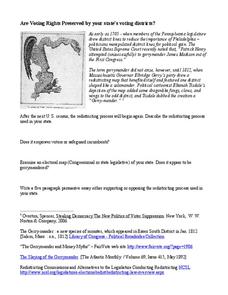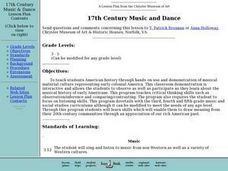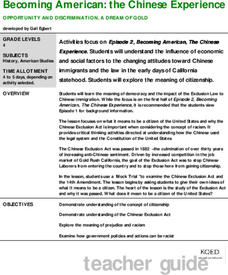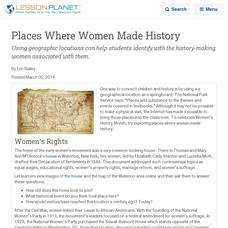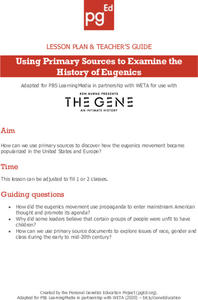Curated OER
Supreme Court
Eleventh graders explore the redistricting process. In this American Government instructional activity, 11th graders examine the electoral map. Students write an essay posing an argument for the redistricting process.
American Museum of Natural History
What's This? Gold
Cell phones are likely made of gold—at least part of them! An interesting lesson explains the conventional and not-so-conventional uses of the popular element gold. From the Inca empire to modern-day technology, learners discover gold...
American Museum of Natural History
Extreme Mammals
Extreme characteristics can create some unusual mammals. Learners flip through a slide show of some of the most interesting mammals that are both living and extinct. Implement as a remote learning resource or use in-class to review...
Curated OER
17th Century Music and Dance
Students explore American history through hands-on use and demonstration of musical material culture representing early colonial America. They compare the music of colonial America to modern music.
Curated OER
Robert Fulton and the Steamboat, "Trail of Tears"
Second graders study Fulton and his Steamboat, the "Trail of Tears," the Oregon Trail, the Transcontinental Railroad and the Pony Express in this series of lessons.
Curated OER
The Colonies: An Adertisement
Students explore the early colonies of American settlements. After researching important characteristics such as land, politics, economics, and educational opportunities, students create their own advertisement for one of the colonies.
Curated OER
Opportunity and Discrimination, A Dream of Gold
Students focus on what it means to be a citizen of the United States and why the Chinese Exclusion Act is important when considering the concept of racism.
Curated OER
Tacoma Narrows Bridge
Students, in groups, create a profile of different Pacific Northwest explorers. They develop PowerPoint presentations and maps to showcase their findings.
PBS
The March on Washington and Its Impact
High schoolers read Martin Luther King, Jr's speech that he gave in Washington. They identify the social conditions that led to the civil rights movement. They discuss the significance of the March on Washington.
Curated OER
What Was Columbus Thinking?
Why is Christopher Columbus one of the most studied figures in history? Upper graders will investigate why Christopher Columbus traveled to the New World and what happened to the native people he encountered. They read and discuss...
Curated OER
The Gettysburg Address
Who was Abraham Lincoln, and what is the Gettysburg Address? Sixth graders participate in a seminar where they read and analyze the Gettysburg Address and its importance. The role of Abraham Lincoln during the Civil War is also...
Curated OER
Ancient Hunters of the Great Lakes
Students describe theories on how the first humans came to America and show the evidence that supports it. In this investigative lesson students study given material and prepare written or oral reports in their groups.
Curated OER
A Country of Migrants?
Students list reasons in support or rejection of the United States being a country of migrants through a written statement and discussion. They answer questions posed regarding immigration.
Curated OER
What is Migration
Students conduct individual research and participate in discussion be able to identify difference between forced and voluntary migration. They identify if push and pull factors are caused by political, social, economic, or environmental...
Curated OER
Vermont History True / False
In this Vermont history worksheet, learners read two and a half pages of information about Vermont history. After reading, students complete 10 true or false questions about what they read.
Curated OER
I Have No Money, Would You Take Wampum
Learners engage in a discussion about their experiences with goods, services, and money. In this bartering lesson, students read The Wampum Bird story and brainstorm their personal experiences with economics.
Japan Society
Popular Culture and Japan’s Gross National Cool
From Manga to Godzilla and Pokemon, Japanese pop culture has been taking the globe by storm. This phenomenon is called "soft power." Learners will examine the differences between hard and soft power, as well as learn the historical...
Curated OER
Places Where Women Made History
Using places can help students identify with the history-making women associated with them.
Curated OER
Noncombatancy and the Seventh day Adventist Church
Upper graders investigate how the Seventh Day Adventists are objectors to the practice of war. The lesson covers the Civil War and examines the church's position about the practice of war. The research extends to modern wars and learners...
Curated OER
Writing Women: The Yellow Wallpaper
Students examine the historical, social, cultural and economic context of Charlotte Perkins Gilman's story, The Yellow Wallpaper. Students determine the place of the middle class woman and her role in society.
Curated OER
What Did it Look Like When Europe Met America?
Students view the film 'Black Robe,' which further develop students' abilities to see an event or era of history from multiple perspectives. After the movie, they utilize worksheets imbedded in this plan to write about what they've seen.
Personal Genetics Education Project
Using Primary Sources to Examine the History of Eugenics
Eugenics philosophy takes survival of the fittest to a whole new level. With a research-focused activity, young scientists examine the history of the eugenics movement and its impact on society. Pupils engage with a video clip, primary...
Alabama Department of Archives and History
Alabama Tenant Farmers and Sharecroppers, 1865 to Present
The tenant farming and sharecropping systems that developed in the South after the Civil War, the reasons for their development, and the eventual decline of these systems are the focus of this two-day plan.
Museum of Tolerance
Disenfranchised People of the New Nation
Why are some immigrant groups in the United States embraced while others become disenfranchised? To answer this question, teams investigate why groups emigrated to the US, why some of these these peoples were...
